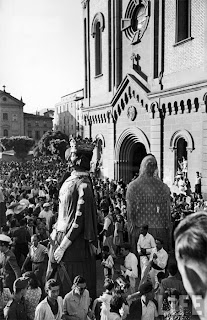HISTORY
According to a rather obscure tradition, during the procession of San Fermín in 1276, three Giants, called, Peru Suziales, Mari Suziales, his wife, and one called Jusef Lukurari (" The Usurer") - a personification of the popular repulsion against the Jews at that time, - were paraded dancing through the streets.
But the first authentic references to The Giants in San Fermin date from the beginning of the XVII century; in 1607 one Joanes de Azcona is named as being responsible for bringing out the assemblage of Giants along with a minstrel who was responsible for providing the accompanying music. In 1620 it is recorded that a carpenter, Joan de Torrobas, was paid 88 "reales" to mend four Giants.
It was the custom around that time to parade Giants in the evenings, after the bullfights, which were adorned with crackers and fireworks,(not unlike the present-day mechanical contrivance of the "Torch Bull" borne by a human) and which were frolicked around the square, before eventually ending up on the bonfire.
This practice of having Giants in the celebrations continued through the greater part of the XVIII century, until in 1780, The King, Carlos III, banned " the use of dancing Giants for leading any religious processions inside or outside all churches within this Kingdom" (by Royal Decree of tenth of July, 1780) which put a stop to the use of any Giants during the San Fermin celebrations. The Giants which had belonged to the Town Hall disappeared without any further trace while the Giants which belonged to the Cathedral were stored away and forgotten about, until 1813 when they were discovered by a carpenter who revived the old tradition by bringing them out once again into the streets. The response was so enthusiastic that The Town Hall gradually built up their own collection of Giants, along with accompanying figures such as the Zaldikos, Kilikis, and Cabezudos.
The Giants that are presently in use date from 1860 and were made by one Tadeo Amorena, a local painter from Pamplona. He presented a scheme to the Town Hall in March of that year to built four new Giants which would represent the "four corners of the world" and which would be more durable and yet lighter than the old ones. A local poet- one Ignacio Baleztena- couldn't help but write some caustic lines on the fact that :
"It seems poor Tadeo had never heard tell of The Oceanic Continent".
The present cabezudos in use were built in 1890 by one Félix Flores. Some of kilikis and zaldikos are from the last century while the rest date from this century.




1 comentario:
Muy interesante su Blog. Aqui hay muchos recusros para el alumno. Keep up the good work!
Publicar un comentario